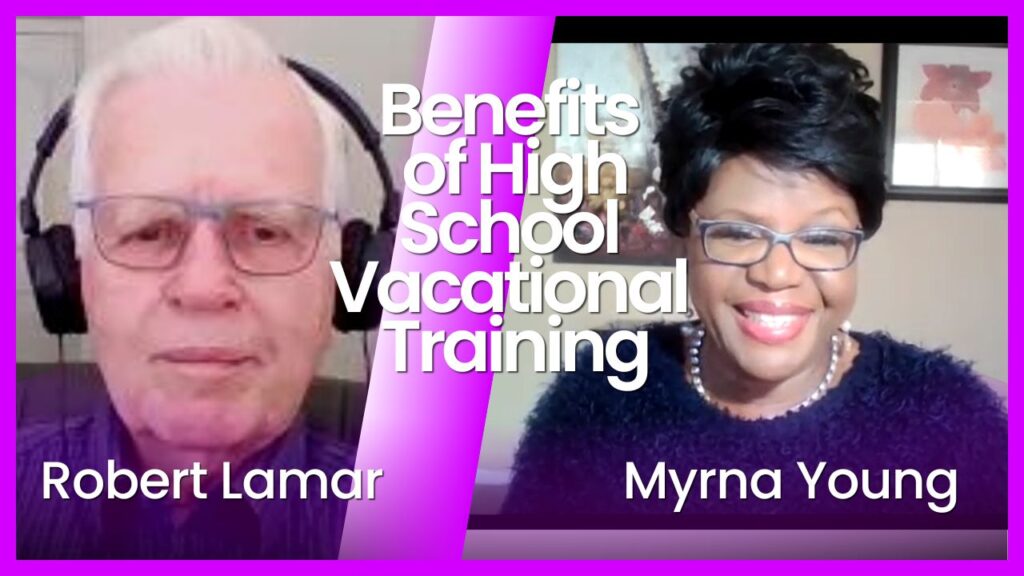Robert W. Lamar, author of “The Value of High School Vocation Training,” joins Myrna Young on the Transform Your Mind to Transform Your Life podcast. Lamar shares his personal experience on the, benefits of vocational training, in high school and how it helped shape his successful, career in construction. He emphasizes the, benefits of vocational training, for students who may not have the means or desire to attend college. Lamar hopes his book will promote the importance of, vocational programs in schools, and encourage students to consider this valuable alternative.
Download the podcast here:
Introduction to vocational training
Robert’s journey began in Washington, DC, where he spent his childhood in the Hillcrest Home for Children. Growing up without a father, he faced many challenges but found solace in, vocational training, during high school. He started working early to support himself and discovered the opportunities that, vocational training, classes offered.
During his sophomore year, Robert stumbled upon a vocational program in landscape planning and engineering. This program, sponsored by the Army Corps of Engineers, taught him how to use transits and levels, prepare site plans, and do topography on drawings. The Army Corps of Engineers even guaranteed a job with the Coastal Geodetic Survey upon graduation.
“I was fascinated to learn how to use transits and levels and do drawings. The program went beyond just landscape planning and engineering. We assisted with drawings for different sites, showing where to place plants and trees. It was a comprehensive learning experience.” – Robert
Robert’s passion for, vocational training, continued in his junior and senior years when he switched to, architectural drafting. Under the guidance of Mr. Muth, his teacher, Robert honed his skills in, drawing structural and architectural plans. He even had the opportunity to work on real projects for the Montgomery County School Board, helping design wood shops, metal shops, and automotive shops for new school buildings.
Affliate Ad
app.deciphr.ai/auth/signup/?ref=Transform
Do you have a podcast? Let Deciphr Ai create your show notes, trancript, blog articles and social media posts.
Deciphr AI turns podcast transcripts into timestamps & show notes in less than 60 seconds. Deciphr AI saves stressed out podcasters one episode at a time with 100% free show notes. Social Captions. Transform Audio To Text. Video Reels.

Vocational Training led to career in Construction
“I learned how to draw anything and everything needed inside a building. This experience laid the foundation for my career in construction.” – Robert
Upon graduating from high school, Robert was offered a job by an architect who had reviewed his work. He worked as an, architectural draftsman, for four years, gaining valuable experience in the field. This paved the way for his career in construction, where he specialized in building one-of-a-kind laboratories in Maryland and Washington, DC.
“The knowledge and experience I gained from, vocational training, helped me excel in my career. I could draw any part of a building, whether it was below ground or above ground. It paid off tremendously.” – Robert
After working for various companies, Robert decided to start his own construction company, which he successfully ran for 15 years. He built high-end office buildings and even had the opportunity to work on prestigious residential projects for Aaron Spelling and Jerry Parencio.
Affliate link
Amazon Prime Big deals

Vocational training led to my own construction company
“My construction company allowed me to showcase my skills and work on remarkable projects. From high-end offices to luxurious residences, vocational training, opened doors for me.” – Robert
Inspired by his own journey, Robert wrote “The Value of High School Vocational Training” to shed light on the, benefits of vocational training. He wanted to encourage mothers, high school students, and anyone listening to consider the, benefits of vocational training.
“I wrote this book to highlight the importance of, vocational training, for students who may not have the means or desire to attend college. Vocational programs, provide valuable knowledge and experience, enabling students to secure well-paying jobs without the burden of student loans.” – Robert
Robert’s book also aims to promote the incorporation of, vocational programs, in high schools across the country. He believes that each community should tailor their, vocational training, offerings to meet the specific needs of their area.
Affliate Ads
Russell Brunson Secrets of Success

Vocational training programs in High School
“Vocational training programs, should be designed to address the demands of the local job market. By doing so, we can equip students with the skills they need to succeed in their communities.” – Robert
The implications of, vocational training, are vast. It not only provides students with practical skills but also instills a sense of confidence and purpose. By offering, vocational programs in high schools, we can bridge the gap between education and employment, ensuring that every student has the opportunity to thrive.
“Education is never wasted, and, vocational training, is a testament to that. It opens doors and unlocks opportunities for success.” – Robert
Conclusion
In conclusion, Robert Lamar’s journey from, high school vocational training, to a successful career in construction is a testament to the, benefits of vocational training. His book, “The Value of High School Vocational Training,” serves as a guide for students, parents, and educators, emphasizing the, benefits of vocational training, in shaping the future workforce.
By investing in, vocational training, we can empower students to pursue fulfilling careers and contribute to their communities. Let us embrace the potential of, vocational education, and create a future where every student has the opportunity to transform their lives through practical skills and knowledge.
As we move forward, let us remember the words of Robert Lamar, “There’s no limit to what, vocational training, can teach you. It all depends on the programs developed in each school and the needs of the local community.”
Namaste.






